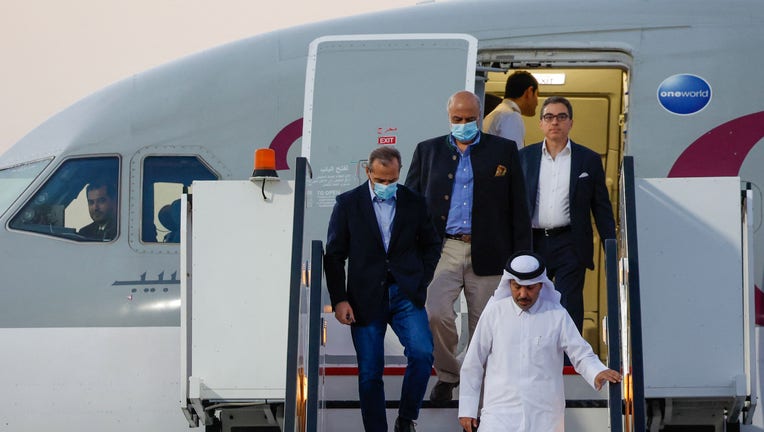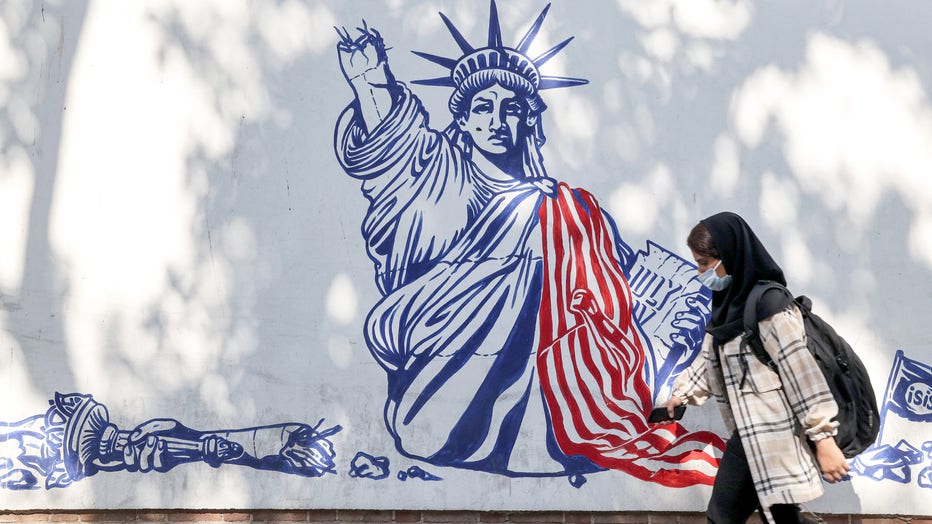5 prisoners sought by US in swap with Iran have been freed as part of $6B assets deal

US citizens Siamak Namazi (R), Emad Sharqi (L) and Morad Tahbaz (C) disembark from a Qatari jet upon their arrival at the Doha International Airport in Doha on September 18, 2023. Five US detainees, three previously identified as Siamak Namazi, Morad
Five prisoners sought by the U.S. in a swap with Iran flew out of Tehran on Monday, officials said, part of a deal that saw nearly $6 billion in Iranian assets unfrozen.
Despite the deal, tensions are almost certain to remain high between the U.S. and Iran, which are locked in various disputes, including over Tehran’s nuclear program. Iran says the program is peaceful, but it now enriches uranium closer than ever to weapons-grade levels.
The planned exchange has unfolded amid a major American military buildup in the Persian Gulf, with the possibility of U.S. troops boarding and guarding commercial ships in the Strait of Hormuz, through which 20% of all oil shipments pass.
President Joe Biden welcomed the news of the release in a statement, saying "five innocent Americans who were imprisoned in Iran are finally coming home."
He urged Americans not to travel to Iran, and he demanded more information on what happened to Bob Levinson, an American who went missing years ago. Biden also announced sanctions on former Iranian President Mahmoud Ahmadinejad and the Iranian Ministry of Intelligence.
Two people, including a senior Biden administration official, said that the prisoners left Tehran on Monday. They spoke on condition of anonymity while the exchange was ongoing.
In addition to the five freed Americans, two U.S. family members flew out, according to the Biden administration official.
Flight-tracking data showed a Qatar Airways flight take off from Tehran’s Mehrabad International Airport, which has been used for exchanges in the past. Several of the former prisoners could be seen climbing the stairs to the flight in video released by Iranian media. The plane later landed in Doha, Qatar.
RELATED: New US sanctions target methods allowing Russia to get Western tech for war
Meanwhile, Nour News, a website believed to be close to Iran’s security apparatus, said two of the Iranian prisoners had arrived in Doha for the swap.
Earlier, Iranian Foreign Ministry spokesman Nasser Kanaani said that the exchange would take place Monday after nearly $6 billion in once-frozen Iranian assets reached Qatar.
"Fortunately Iran’s frozen assets in South Korea were released and God willing today the assets will start to be fully controlled by the government and the nation," Kanaani said.
"On the subject of the prisoner swap, it will happen today and five prisoners, citizens of the Islamic Republic, will be released from the prisons in the U.S.," he added. "Five imprisoned citizens who were in Iran will be given to the U.S. side."
He said two of the Iranian prisoners will stay in the U.S.
Mohammad Reza Farzin, Iran’s Central Bank chief, later came on state television to acknowledge the receipt of over 5.5 billion euros — $5.9 billion — in accounts in Qatar. Months ago, Iran had anticipated getting as much as $7 billion.
The planned exchange comes ahead of the convening of world leaders at the U.N. General Assembly this week in New York, where Iran’s hard-line President Ebrahim Raisi will speak.

A woman in a medical mask walks past a mural depicting the Statue of Liberty with the torch-bearing arm broken, painted on the outer walls of the former US embassy in Iran's capital Tehran on October 9, 2021. (Photo by Atta Kenare/AFP via Getty Image
The deal has already opened U.S. President Joe Biden to fresh criticism from Republicans and others who say that the administration is helping boost the Iranian economy at a time when Iran poses a growing threat to American troops and Mideast allies. That could have implications in his reelection campaign as well.
On the U.S. side, Washington has said the planned swap includes Siamak Namazi, who was detained in 2015 and was later sentenced to 10 years in prison on spying charges; Emad Sharghi, a venture capitalist sentenced to 10 years; and Morad Tahbaz, a British-American conservationist of Iranian descent who was arrested in 2018 and also received a 10-year sentence. All of their charges have been widely criticized by their families, activists and the U.S. government.
U.S. officials have so far declined to identify the fourth and fifth prisoner.
The five prisoners Iran has said it seeks are mostly held over allegedly trying to export banned material to Iran, such as dual use electronics that can be used by a military.
The two that Nour News said were in Doha were: Mehrdad Ansari, an Iranian sentenced to 63 months in prison in 2021 for obtaining equipment that could be used in missiles, electronic warfare, nuclear weapons and other military gear, and Reza Sarhangpour Kafrani, an Iranian charged in 2021 over allegedly unlawfully exporting laboratory equipment to Iran.
The cash represents money South Korea owed Iran — but had not yet paid — for oil purchased before the U.S. imposed sanctions on such transactions in 2019.
The U.S. maintains that, once in Qatar, the money will be held in restricted accounts and will only be able to be used for humanitarian goods, such as medicine and food. Those transactions are currently allowed under American sanctions targeting the Islamic Republic over its advancing nuclear program.
Iranian government officials have largely concurred with that explanation, though some hard-liners have insisted, without providing evidence, that there would be no restrictions on how Tehran spends the money.
Iran and the U.S. have a history of prisoner swaps dating back to the 1979 U.S. Embassy takeover and hostage crisis following the Islamic Revolution. Their most recent major exchange happened in 2016, when Iran came to a deal with world powers to restrict its nuclear program in return for an easing of sanctions.
The West accuses Iran of using foreign prisoners — including those with dual nationality — as bargaining chips, an allegation Tehran rejects.
Negotiations over a major prisoner swap faltered after then-President Donald Trump unilaterally withdrew America from the nuclear deal in 2018. From the following year on, a series of attacks and ship seizures attributed to Iran have raised tensions.
Meanwhile, Iran’s nuclear program now enriches closer than ever to weapons-grade levels. While the head of the United Nations’ nuclear watchdog has warned that Iran now has enough enriched uranium to produce "several" bombs, months more would likely be needed to build a weapon and potentially miniaturize it to put it on a missile — if Iran decided to pursue one.
Iran maintains its nuclear program is peaceful, and the U.S. intelligence community has kept its assessment that Iran is not pursuing an atomic bomb.
Iran has taken steps in recent months to settle some issues with the International Atomic Energy Agency. But the advances in its program have led to fears of a wider regional conflagration as Israel, itself a nuclear power, has said it would not allow Tehran to develop the bomb. Israel bombed both Iraq and Syria to stop their nuclear programs, giving the threat more weight. It also is suspected in carrying out a series of killings targeting Iran’s nuclear scientists.
Iran also supplies Russia with the bomb-carrying drones Moscow uses to target sites in Ukraine in its war on Kyiv, which remains another major dispute between Tehran and Washington.
___
Gambrell reported from Dubai, United Arab Emirates, and Lee from Washington. Associated Press writers Nasser Karimi and Amir Vahdat in Tehran, Iran, contributed to this report.

